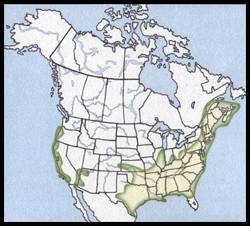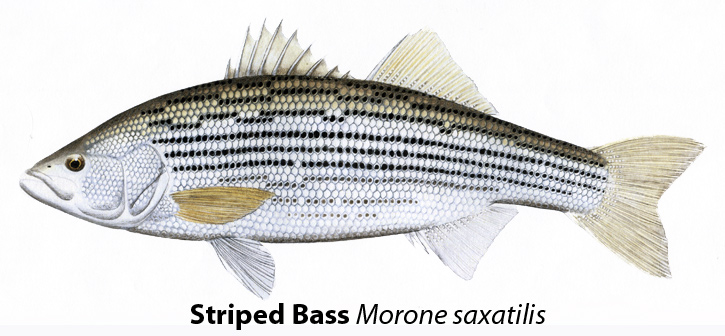Striped Bass, March 2014, Fish of the Month!
A Brief Note to Our Readers:
The Striped Bass is the fourth in our list of members of the Temperate Bass family.
Striped Bass
Morone saxatilis
Local Names:
Striper, Rockfish, Rock, Bass, Sea-bass, Green-head
Average Size:
16 to 26 inches
2 to 8 pound
Occasionally much larger, to 50 or more pounds
Distinguishing Field Marks:
(See the illustration.)
-
The body, gill covers, cheeks and top of the head are scaled.
-
The sides are marked by a series of dark lateral stripes.
-
The head is relatively large with a large mouth. The upper jaw extends to the mid-point of the eye.
The lower jaw protrudes beyond the upper.
-
The 2 dorsal fins are not connected. The first usually has 9 spines (sometimes as few as 7 or as many as 12), the second dorsal has 1 stout spine nearly as tall as the fin on its leading edge.
-
The caudal (tail) fin is moderately forked.

The anal fin has 3 spines on its leading edge.
The leading edges of the paired pelvic fins each have a spine.
North American Range:
Map to the right shows approximate range in North America.
Diet:
At first, small crustaceans and other aquatic invertebrates, moving on to larger invertebrates and fishes. Adults feed heavily on what is available to them, eels, squids, shrimps, Menhaden, Alewives, Mackerel, and in fresh water, primarily on Gizzard shad.
Biology:
Historically Striped bass were an anadromous salt water species entering fresh water to spawn. Much of the Striped bass’s present range is the result of its having been introduced to landlocked fresh water habitats. In either case, Striped bass require moving water for successful spawning. In some watersheds mature fish move into larger rivers in the fall and over-winter there in preparation for the spring spawning. Many enter the spawning water in the early spring.
Spawning usually takes place in May and June, depending on latitude. At that time a single ripe female is surrounded by as many as 7 or 8 males which pressure her toward the surface by bumping her while attempting to attain a dominant position. Once at the water’s surface, the female turns on her side, splashing as she does, and releases her eggs with the attendant males simultaneously clouding the surrounding water with milt. An estimated 80% of the 500,000 to 3,000,000 eggs carried by each female are fertilized in this way. The fertilized eggs absorb water to attain their full size, at which time they become semi-buoyant and drift with the river’s current during their 4 to 6 day incubation period. It is imperative that they drift in this way so that they receive a continuous supply of oxygen. After hatching, as they continue to drift downstream, the newly hatched fish remain inactive as they spend another 10 days absorbing their yolk sacs. It should be noted here that less than 1% of the eggs survive the first 2 months of life.
In salt-water populations, the young take shelter in estuaries as they grow toward adulthood. As adults, some are known to undertake long seasonal migrations while others, born in the same river, may become resident in that system. In fresh water, Striped bass are also known to wander widely in search of food. There are very few inland waters capable of supporting natural reproduction of Striped bass, in these waters, populations are maintained by hatchery stocking programs.
Fly Fishing for Striped Bass:
Over the decades, countless man-hours have been devoted to locating and fishing for this historically important species. In coastal waters, and in their spawning rivers, they are most abundant in spring and again in fall before and after the water has become too warm for their comfort. Striped bass seem to move in schools made up almost exclusively of one year class, with the largest individuals being solitary or found in small schools and the younger fish hunting and feeding in schools of 100 or more.
In landlocked waters, Striped bass will only be close to shore in spring and fall, resulting in fly access to them.
For both you fresh and saltwater fly rod Striped bass outings, you’ll want to carry fairly heavy tackle of at least 8 weight and up to 10 or even 11 weight. Large fish want large meals, so salt water Striped bass flies may be up to 6 inches long. An entire line of salt water flies suitable for Striped bass fishing have been developed over the last 75 or so years and more and more fly fishers are taking to the salt-chuck for their recreation. There is still much ground to be broken in this aspect of the sport and creative fly-tyers using natural and synthetic materials are annually coming out with new creations, often bearing the designer’s name.
Being sometimes both wary and finicky, casting flies and poppers to smaller schooling Striped bass can be as addicting as a good game of golf, appearing, disappearing, and then suddenly re-appearing on a clear water sand bottom salt flat and not taking anything thrown at them, while at other times, they seem to throw caution to the wind and strike anything that comes into range. Like trout, large and small Striped bass will key in on one form of bait and take that to the exclusion of anything else, and that may not always be the largest meal available to them. It behooves anyone seeking these enigmatic critters to learn the food chain in the waters they fish so that they can be prepared when a bunch of 20 pound bass suddenly appear within casting distance and are feeding on something not so easy to see. For smaller Stripers 8 to 9 weight fly rigs will get the job done. If you’re fly-rod targeting the bigger fish, you may want to always be equipped with a 10-11 weight outfit that’ll comfortably cast and present the largest flies and poppers.
Keep in mind that, in the warmer months, the heat of the long days will keep these fish inactive and waiting for the cooler temperatures of night to begin feeding. Where Stripers are the most available fishing drug of choice, there are many anglers who set their schedules according the rise and fall of the local tides, often rising in “the wee hours” to prospect their favorite tidal waters.
Significance to Humans:
As long as humans have inhabited this continent, Striped bass have been an important species, early on as food, and more recently as both food and sport. Until the past 30 or so years, when the species has been strictly regulated primarily as a game fish, thousands of pounds of Striped bass found their way to market, often landed by local surf anglers needing to pay for the fuel for their next trip to the beach. The species was also heavily commercially harvested in nets set out from small boats rowed through the surf and hauled back to the beach by hand. Much controversy has surrounded the present regulations reserving the coastal Striped bass as a game fish species. There are efforts underway to re-allow the fish to be taken commercially. Partly for that reason, and partly because mariculture has begun to come into its own, Striped bass are being pen-reared and commercially marketed. Of course this industry has raised both scientific and citizen based cries of foul, especially where habitat degradation and introduction of non-native species through fish-farm escapes have been the unintended ripple effects of this young industry. Still, most of the Striped bass found at grocery store fish counters have been raised in captivity.
Status:
As stated above, landlocked inland populations of Striped bass are maintained entirely by annual stockings.
Presently, after a severe downturn in the latter 25 years of the 20th century, coastal Striped bass have been more consistently maintaining and thriving, especially in the mid-portion of their native east coast range. It is presently less successful in the northern reaches of that range.
Striped bass remain a species of concern in the central-northern California coast range to which they were introduced and in which they once enjoyed significant abundance.







